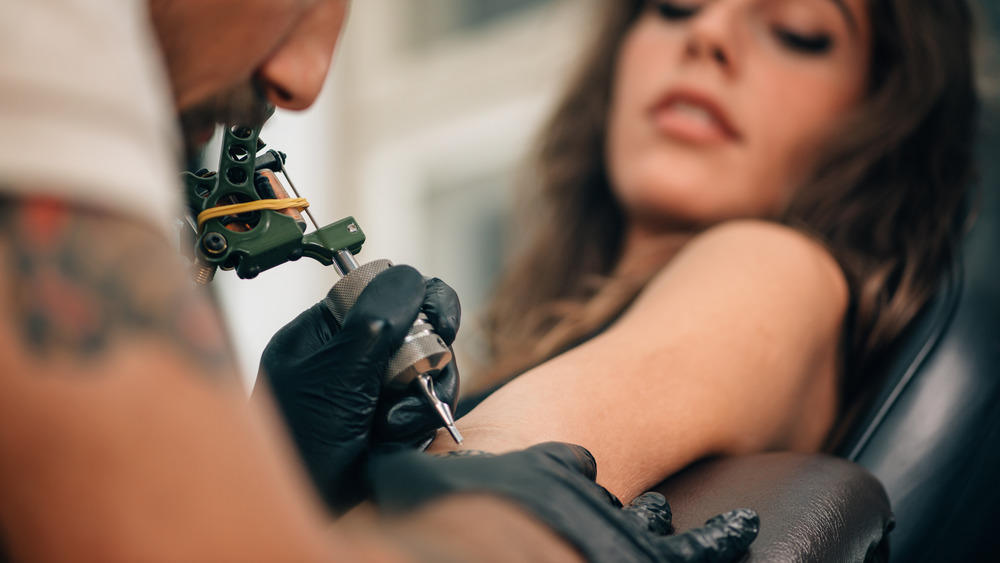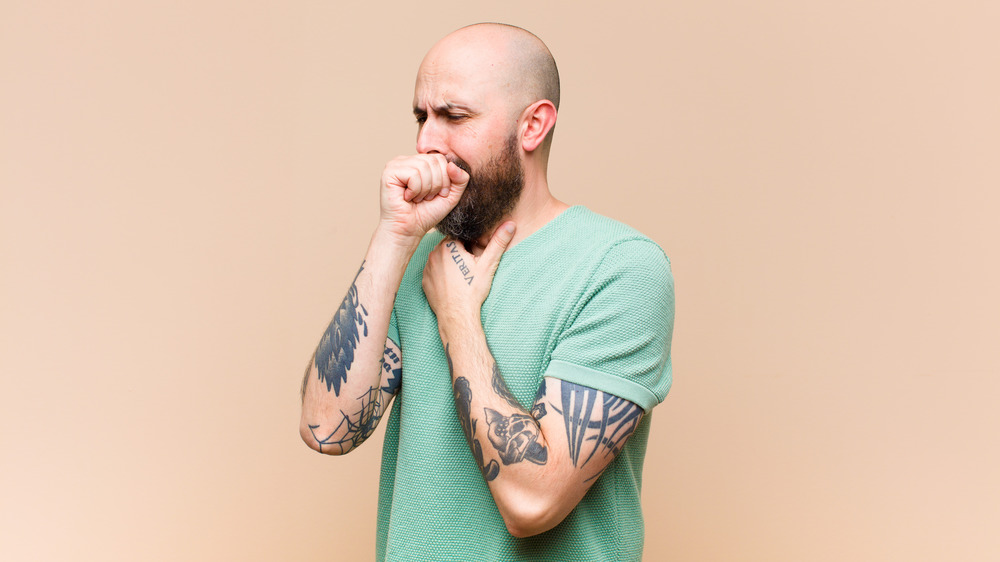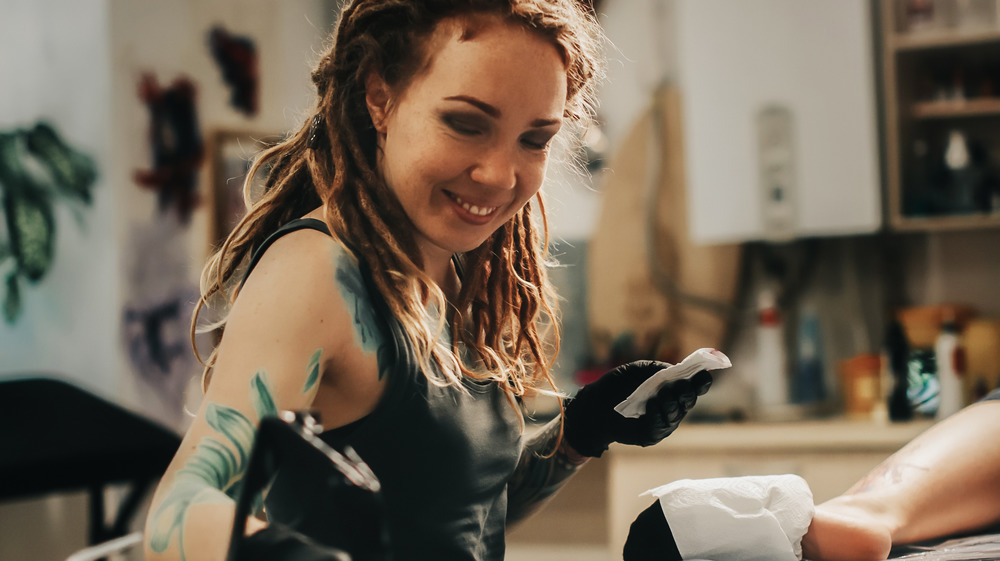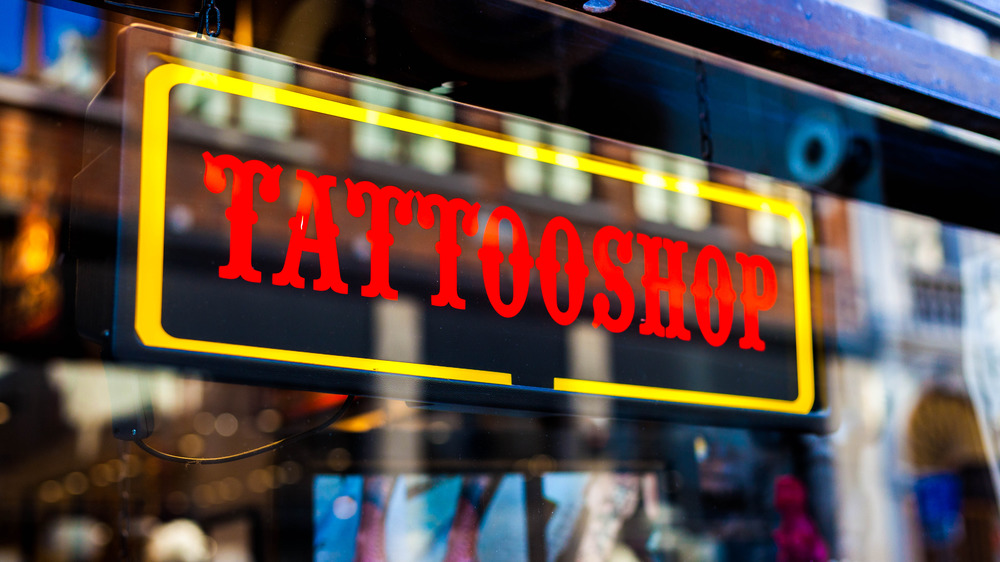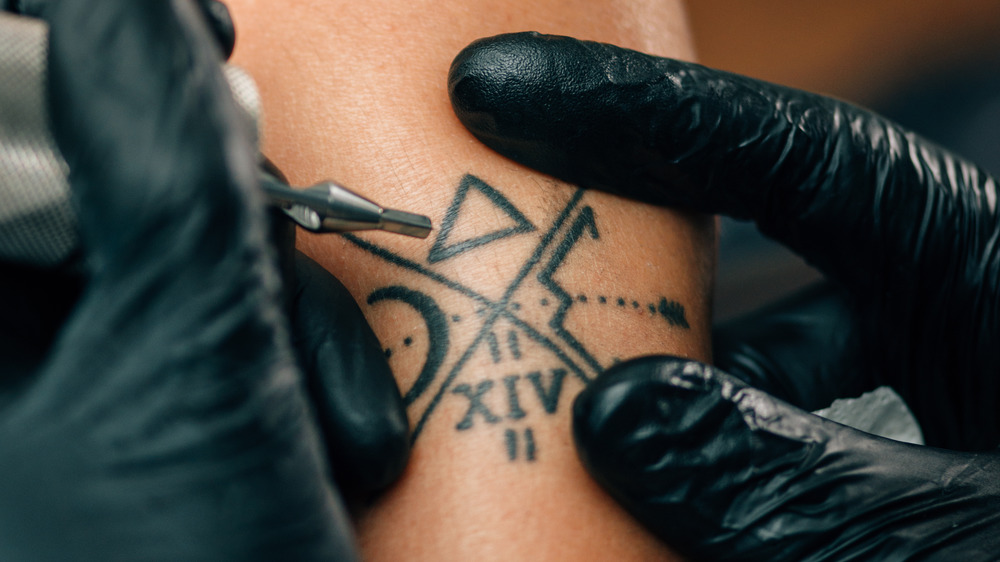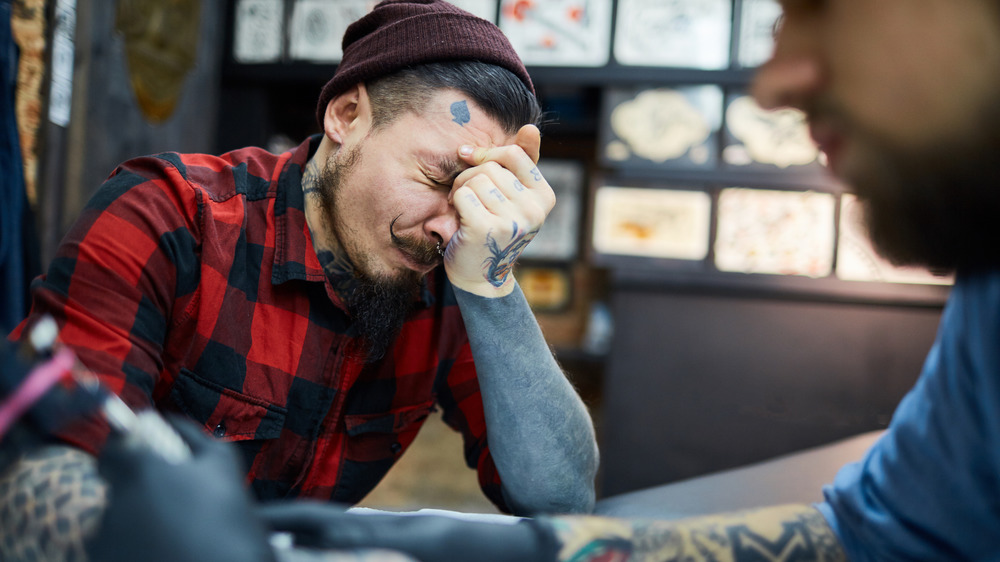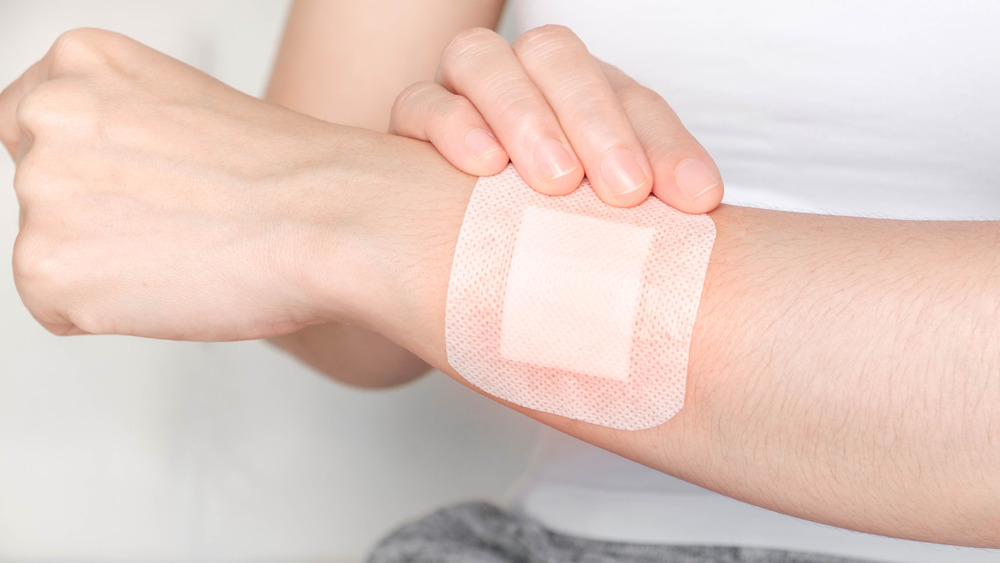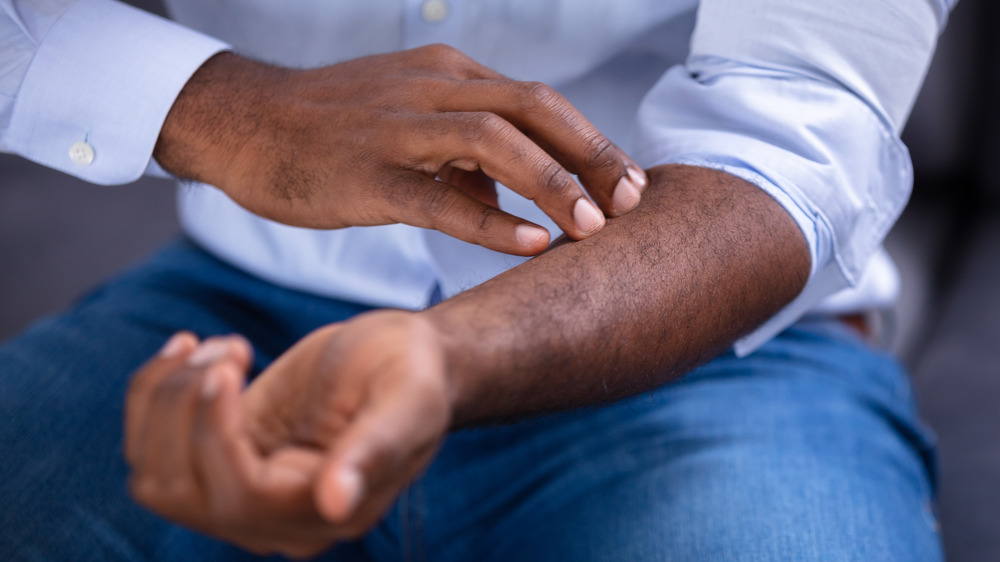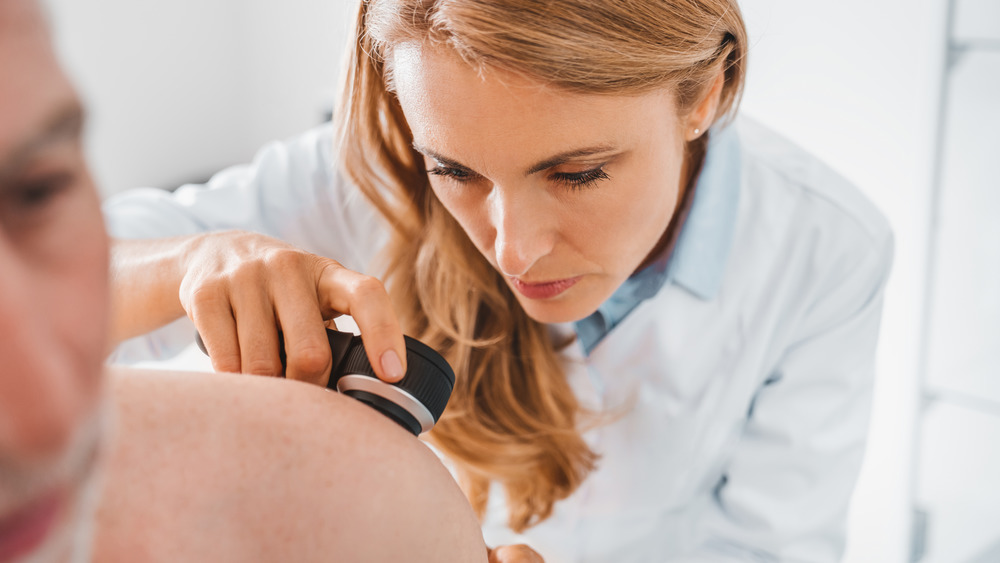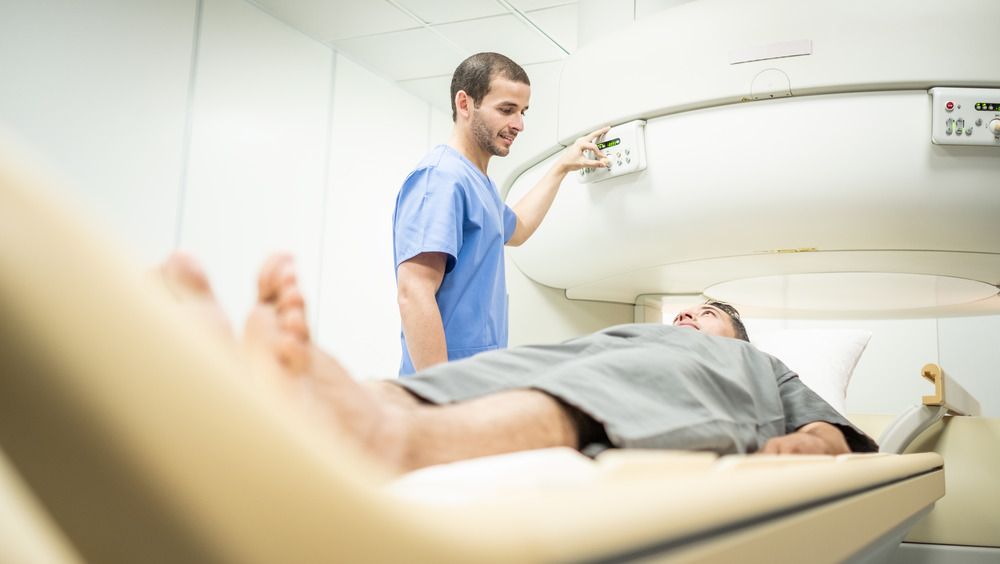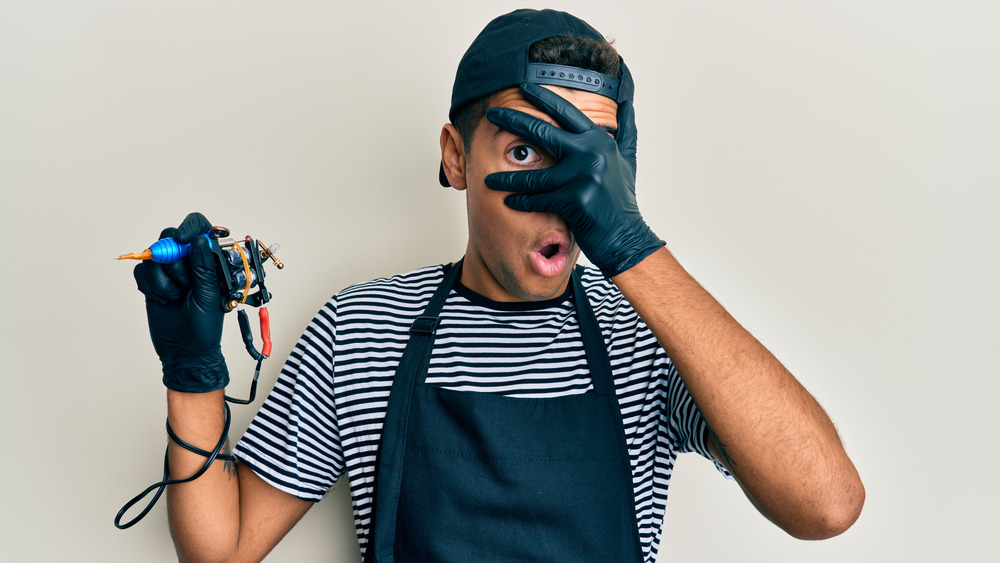Everything You Need To Know Before Getting A Tattoo
Tattoos were once associated mostly with sailors, carnival performers, and sulking teenagers looking to rebel against their parents, but they've since become almost mainstream. A poll conducted in 2019 by the market research company Ipsos found that three out of ten Americans have tattoos. And that's an increase of nearly 10 percent since 2012. A 2016 survey by The Harris Poll found that tattoos are even more common among certain age groups; in that poll, almost half (47 percent) of those aged 18 to 35 had at least one tattoo.
But just because tattoos are so popular, that doesn't mean you shouldn't think carefully before getting one. Getting a tattoo is not a trivial act: A hand-held machine pierces your skin with needles hundreds of times, depositing ink beneath the surface that leaves a permanent — or at least very difficult to remove— image on your body (via Mayo Clinic). If you're considering a tattoo, here's what you should know before getting inked.
Getting a tattoo could temporarily weaken your immune system
You might be more likely to catch a cold after you get your tattoo. As part of a study published in the American Journal of Human Biology, researchers at the University of Alabama measured the levels of an antibody that protects against colds and other infections in a group of volunteers before and after a tattoo session. They found that levels of the antibody were lower after the stress of getting a tattoo, indicating a temporarily weaker immune system, the researchers told ScienceDaily. However, they also found that the more tattoos a person had, the less impact the tattoo process had on their immunity.
Repeated tattooing seems to allow the body to adapt to the stress, boosting the immune system's ability to stay strong despite injury. The researchers noted that this jibes with observations by tattoo artists that people who have lots of tattoos heal quickly, and with the traditional notion that tattoos "toughen up" the body.
The stigma of tattoos is fading fast
Will a tattoo cause people to form a negative opinion about you? In the past, tattoos tended to be associated with gangs and other unsavory elements (via Houston Chronicle). But there's evidence that attitudes about tattoos — let's just call them "tattitudes"— are changing.
In 2018, researchers from the University of Miami Business School and University of Western Australia surveyed over 2,000 people, and found that having a tattoo had zero effect on their wages or employment. Their data, published in Human Relations, showed that people with tattoos were just as likely to gain employment as those without, and that on average people with tattoos earned as much money as those without.
In a 2016 survey by The Harris Poll, more than half of those polled said they'd be comfortable with a person who had a visible tattoo serving in an number of specific careers. This includes jobs like a police officer, doctor, primary school teacher — and even presidential candidate!
The U.S. military has tattoo restrictions
If you're serving in the armed forces or plan to enlist, you should check the regs before getting a tattoo. All branches of service forbid tattoos that are obscene or indecent, or promote extremist, sexist, or racist views.
According to the United States Army's website, the branch updated its uniform and appearance regulations in 2015 to permit an unlimited number of tattoos on the arms, legs, and body. However, "tattoos above the T-shirt neck line" — neck, face, and head — remained prohibited. Hand tattoos are also banned with the exception of one "ring tattoo" on each hand. Similar to the Army, the United States Air Force disallows tattoos above the collar level, including the head, neck, scalp, and face. Hand tattoos are limited to one "single-band ring tattoo" on one hand.
The United States Navy allows tattoos anywhere except the head, face, and scalp, and a single tattoo is allowed on the neck, no bigger than one inch in any direction. Although stomach and back tattoos are permitted, tattoos "on the torso area of the body shall not be visible through white uniform clothing," according to the Navy's grooming standards. The United States Marine Corps allows unlimited tattoos on areas of the body covered by the physical training uniform, so head and neck tattoos are out. Regulations limit the size, number, and placement of tattoos on the arms and legs.
Regulations for tattooing vary by state
Did you know that in Georgia, it's illegal to tattoo within one inch of the eye socket? In Washington D.C., tattoo artists must be registered with the mayor's office. Yes, the laws that regulate where, by whom, and under what conditions tattooing can be done vary from one state to the next. Interestingly, Nevada is the only U.S. state with no statewide tattoo regulations.
Many states require tattoo establishments to pursue licensing or certification. Some lay out sanitization and public health guidelines, while others leave those details to local municipalities or don't address them at all. Most states have deemed it illegal for minors to get tattoos, though in some places parents can grant permission. As you look for a tattoo parlor, it's important to know the local statutes so you can check that the shop is following them. You can find the regulations for your state on the National Conference of State Legislatures' website.
You should look for safe practices at tattoo shops
In addition to state regulations, all tattoo shops must follow the OSHA (Occupational Health and Safety Administration) guidelines regarding exposure to bloodborne pathogens. This is to prevent transmission of illness or infection. According to the medical waste disposal company U.S. Bio-Clean, these rules mean the tattoo artist must wear gloves and eye protection while working, and that anything which contacts the client's skin must be sterilized, used only once, and discarded after. This includes needles, ink tubes, trays, and containers. Needles are never used by hand, and needles and ink tubes should be in sealed packages before use. Markers used to draw a design on your skin should also be single use. However, stencils can be reused if sterilized between uses.
Tools that aren't disposable must be sterilized before each use with an autoclave, a device that uses heat to kill off harmful pathogens. Tables, work surfaces, drawer handles and the like should be sterilized with a disinfectant or bleach solution. OSHA requirements stipulate that a tattoo shop must have uncarpeted floors, separate work and waiting areas, good lighting and ventilation, and separate work tables and cabinets for each artist to keep their instruments and materials. If you notice anything amiss, you'll want to look for a different tattoo shop.
This is how you should choose your tattoo
Having a permanent image placed on your body should entail more thought and consideration than buying a new T-shirt, right? So put significant time and thought into picking your tattoo. Inked magazine recommends that you start by researching tattoo artists. Don't just look for designs that are aesthetically pleasing, but look for ones you personally connect with (via Inked). A tattoo that's in synch with your personality and reflects who you are is more likely to be treasured for decades to come, according to the magazine. Share your tattoo ideas with friends, especially any who have tattoos themselves, for feedback. Take as much time as you need, even if it's a year or more.
Once you land on a concept, contact a tattoo shop or artist for a consultation. The artist will help you refine your idea and advise you on size, placement, practicality, colors, and other details. Be flexible and collaborative when consulting with your tattoo artist; their experience and skill will help you zero in on a tattoo that's uniquely your own.
Yes, getting a tattoo will hurt
Tattooing involves needles piercing your skin — without an anesthetic – so there's no way you're not going to feel it (via Mayo Clinic). The intensity can range from a dull ache to sharp, stinging, or vibrating pain. It depends on many factors, including your general tolerance of pain, the skill of the artist, and the location of the tattoo, according to Healthline.
Tattoos on some body parts tend to be more painful than others. Places with thicker skin, more fat, and fewer nerve endings tend to hurt less. The forearms, upper and lower back, outer shoulders, upper outer thigh, and calves are the least painful spots for a tattoo. The most painful areas are the rib cage, nipples and breasts, knees and elbows, abdomen, hips, neck, hands and fingers, feet and toes, and the armpit. In fact, armpit tattoos are so painful that most tattoo artists advise against them, Healthline revealed.
Whatever your choice, you can take steps to reduce the pain. Stay hydrated so your skin will be supple, and avoid alcohol or caffeine beforehand. Get a good night's sleep; your body will handle pain better if you're well rested. And while getting your tattoo, feel free to request breaks. If the pain gets intense, you can ask the artist to pause.
You need to take care of your tattoo
"In the first days to weeks after receiving a tattoo, the skin is vulnerable to infection," Dr. Marie Leger, a board-certified dermatologist in New York City and a member of the American Academy of Dermatology, told Health Digest. "While the best practices haven't been studied in a controlled setting, some experienced tattoo artists suggest keeping it covered with a bandage or dressing while the skin heals, which is good advice."
Dr. Leger recommends keeping the area clean during healing — wash it daily with soap and water, and wash your hands before removing or changing the dressing. Use a water-based moisturizer like Aquaphor to keep the skin from drying out; petroleum jelly (Vaseline) or other oil-based products that contain no water may cause the ink to fade. Avoid scented products, even if made from natural ingredients, because they can trigger a skin allergy after a recent tattoo. "Even all-natural products, like essential oils, can cause allergies," noted Dr. Leger.
Watch for warning signs after getting a tattoo
As your skin heals, you can expect the normal healing process: redness, swelling, soreness, clear fluid, itchiness or flaking, and scabbing, per the American Academy of Dermatology (AAD). But it's important to watch for signs of an infection or other problems, and see your doctor if you suspect something's wrong.
Infection can be signaled by redness or pain that gets worse instead of better. An itchy or painful rash, pus, an open sore, and fever or chills can signal an infection, which can set in immediately, or in the days or months following the tattoo.
Some people develop an allergic reaction to the tattoo ink. Red ink seems to be the most common culprit, but any color can trigger it, according to the AAD. Allergies sometimes happen years or even decades later. Signs of allergy include redness and swelling, itching, as well as bumps, lumps, or raised scaly patches. Keep an eye out for blisters, crusting or flaking skin, or fluid leaking from the area. If you suspect an allergy and symptoms are mild, you can check with your tattoo artist for advice or see a dermatologist. Definitely see your doctor or a dermatologist if symptoms are serious or intense, or they last more than two weeks, advised the AAD.
The sun can cause tattoo trouble
Sunlight sometimes triggers a "sun allergy," in which sun exposure causes a tattoo to become itchy and red, according to the American Academy of Dermatology (AAD). Blisters, bumps, or hives may accompany the reaction, which can occur within minutes of direct sunlight hitting the tattoo, or hours afterward.
"One way this is thought to happen is that UV light stimulates ink particles, or breaks down tattoo ink into byproducts that a person may be allergic to," Dr. Marie Leger, a board-certified dermatologist in New York City and a member of the American Academy of Dermatology, told Health Digest. Keeping tattoos protected with clothing or sunscreen — SPF 30 or higher — is a good idea, she explained.
Protecting your tattoo from the sun will also increase the longevity of the colors of your tattoo, since sunlight tends to fade the ink. And for general skin health, you should be protecting all your exposed skin from prolonged sunlight and staying in the shade when you can, anyway. It's also a good idea to keep your tattoos away from the UV light of sun lamps and tanning booths.
Tattoos and some skin conditions don't mix well
If you have a tendency to form keloids — raised scars that grow longer than the original wound — you may want to rethink getting a tattoo (via American Academy of Dermatology) Keloids are difficult to treat, and they can be itchy or painful. They can also alter the appearance of your tattoo. If you've had keloids in the past, you can try having the artist do some test work in the spot where you're planning a tattoo. If the skin begins to thicken as it heals, it's likely the tattoo will trigger a keloid.
Other skin problems that might be aggravated by, or interact negatively with, a tattoo include eczema, vitiligo, lichen planus, sarcoidosis, skin cancer, and psoriasis. With psoriasis, in particular, skin injury can trigger a flare. If you have this condition or it runs in your family, getting a tattoo could cause symptoms. If you have a history of any of these skin conditions, talk with your doctor or dermatologist before getting a tattoo, advised the AAD.
It's hard to say how common it is for tattoos to cause reactions
While most complications, if they occur, will happen shortly after a tattoo is applied, it's possible for a bad reaction to occur long afterwards. A small 2015 study published in Contact Dermatitis found that among 300 people with tattoos, 10 percent reported an adverse reaction of some kind, like pain, rash, or severe itch. And 6 percent of those surveyed said their reaction lasted for more than four months. In some cases, these problems lasted several months or as long as four years after the tattoo was received. The problems tended to be associated with a specific ink color, with red ink being the most common trigger.
However, the researchers noted that it's hard to estimate how common these kinds of problems really are, since neither the Food and Drug Administration or any other regulator collects any data on it. They also found that only a third of people who reported a problem sought medical attention, which is an opportunity to remind you: See your doctor if your tattoo is causing you problems.
Some people with tattoos experience discomfort during MRIs
Magnetic Resonance Imaging, or MRI, is a diagnostic technique that uses a strong magnetic field to produce images of the inside of the body, according to the National Institute of Biomedical Imaging and Bioengineering (NIBIB). Doctors use it to help diagnose everything from brain tumors to knee and shoulder injuries. It is a non-invasive procedure, but tattoos inks have metallic components that can interact with the MRI scan, leading to a burning or stinging sensation.
This is a rare phenomenon, and usually a mild one, according to the University of Virginia School of Medicine. Still, if you're undergoing an MRI scan it's best to let your doctor and the MRI technician know about any tattoos you have (via NIBIB). You can request to stop the scan if the sensation becomes uncomfortable. One thing you shouldn't do, though, is avoid an MRI scan because of this concern. The consequences of not getting a good diagnosis are likely worse than the discomfort, per the Food and Drug Administration.
Tattoo removal is possible, but it's not cheap or easy
Research by The Harris Poll found that nearly a quarter of people with tattoos regretted getting them. If things don't work out, tattoo removal is possible. But the process is more complicated and expensive than getting the original tattoo, according to the Mayo Clinic. Scarring isn't uncommon, and the affected skin may be discolored. Some tattoos, like those with many colors, are harder to remove.
There are a few different options to get rid of an unwanted tattoo: Laser surgery, surgical removal, and dermabrasion. Laser surgery uses a specific kind of laser (Q-switched Nd:YAG) to "heat and shatter the tattoo ink" (via Mayo Clinic). Complete erasure may not be possible with this type of removal. Surgical removal is more invasive, as the tattooed skin is completely removed. Although it will work to remove the tattoo, you will have a scar. Lastly, dermabrasion essentially sands down the tattooed area. Results are unpredictable, so this isn't a very common practice.
"Tattoo removal is expensive and time consuming — expect to have multiple sessions over the course of many months," board-certified dermatologist Marie Leger told Health Digest. Essentially: Think carefully. Don't assume you can easily undo a mistake. As Dr. Leger told us, "Like clothing and hairstyles, tattoo styles come and go. So make sure you pick something that you will still like later."

